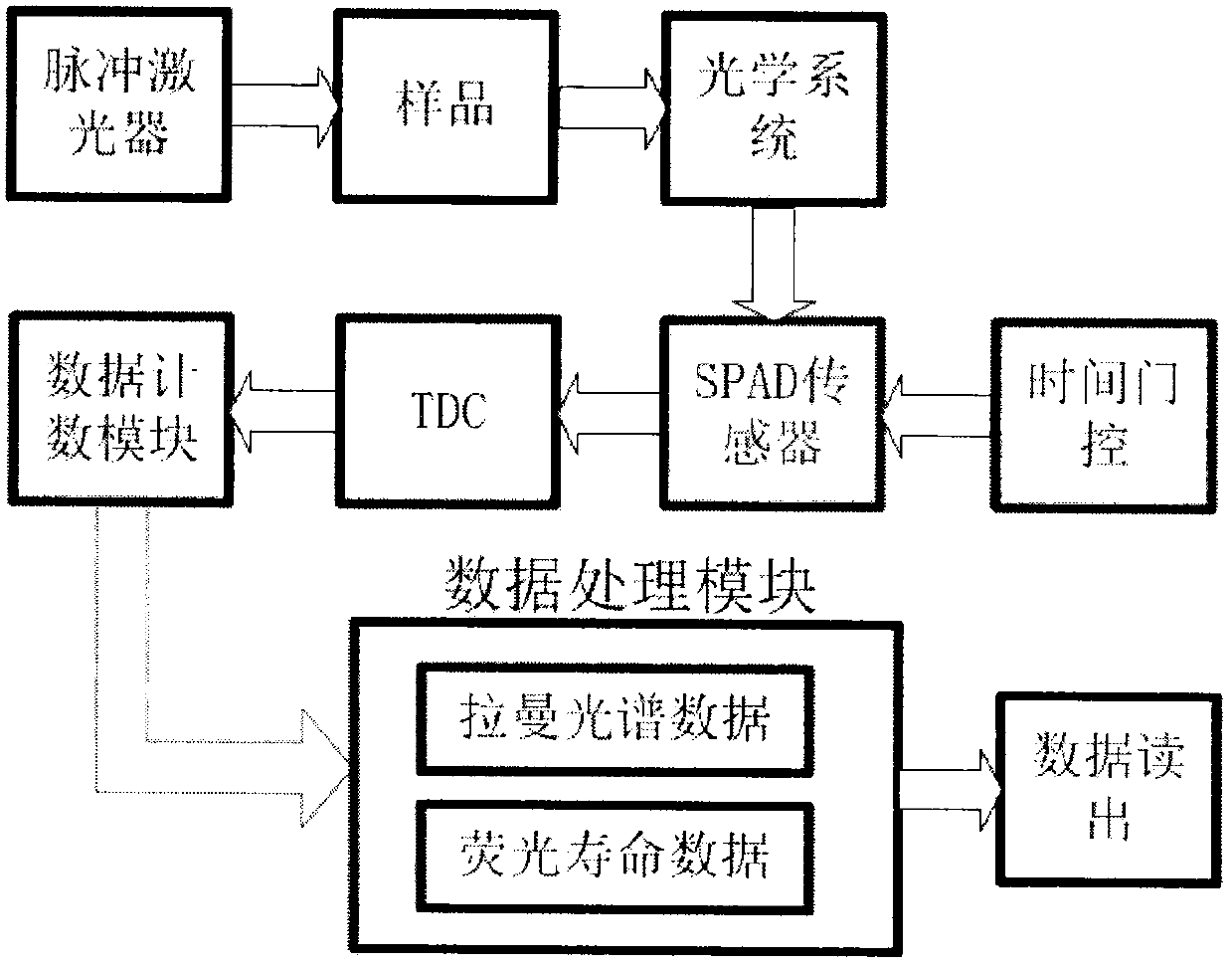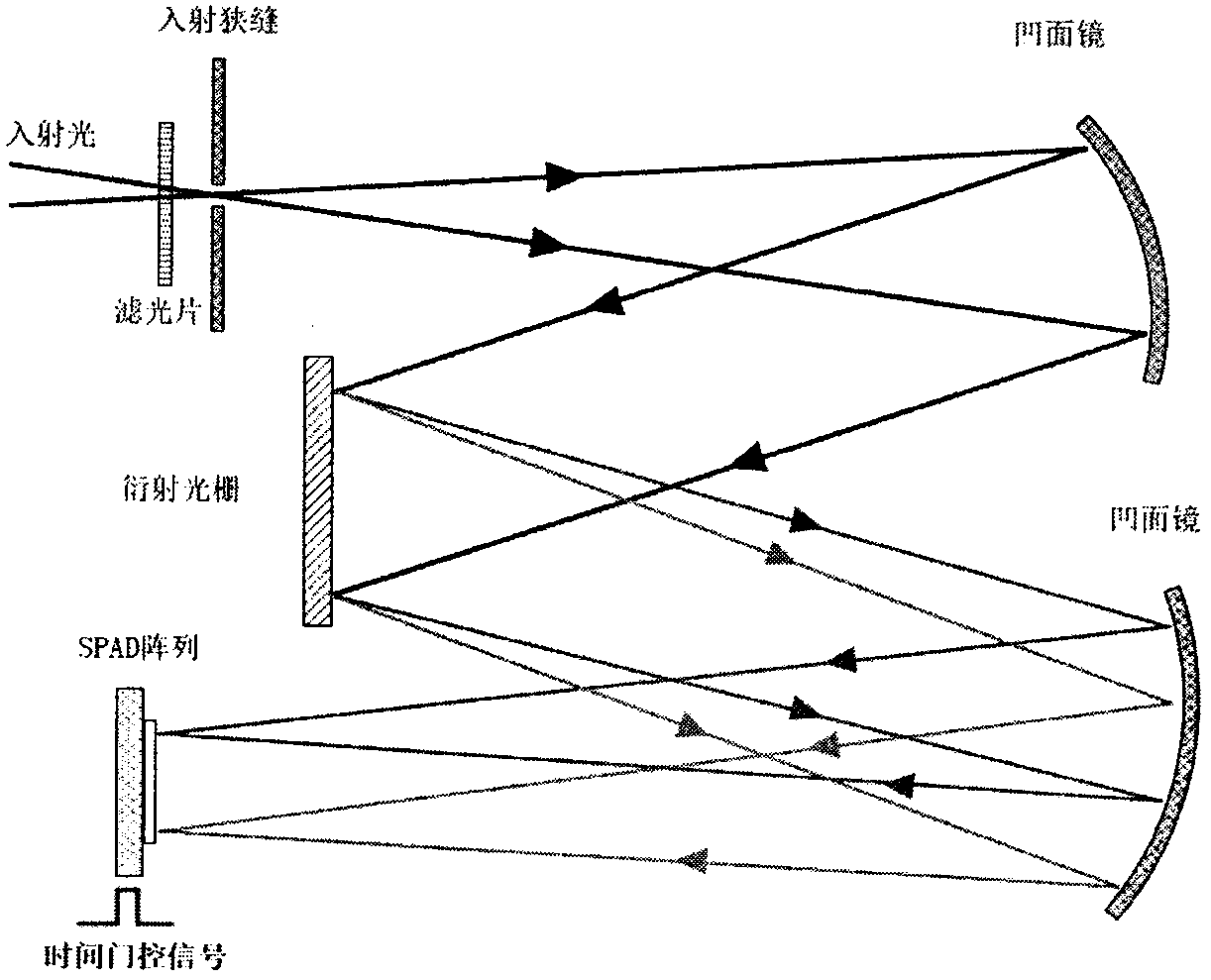Time correlation Raman-fluorescence lifetime spectrometer based on SPAD
A technology of fluorescence lifetime and spectrometer, which is applied in the field of Raman-fluorescence lifetime spectrometer, can solve the problems of low Raman signal-to-noise ratio, low measurement rate, complex system, etc., to improve measurement efficiency, increase signal-to-noise ratio, multi-channel Quantity effect
- Summary
- Abstract
- Description
- Claims
- Application Information
AI Technical Summary
Problems solved by technology
Method used
Image
Examples
Embodiment 1
[0030] Such as figure 2 As shown, a time-correlated fluorescence suppression Raman spectroscopy-fluorescence lifetime instrument based on a SPAD sensor is mainly composed of a pulse laser, an optical system, a time gating circuit, a SPAD array sensor, a TDC module, a data counting module, a data processing module and corresponding software and user interface components.
[0031] The laser light source usually uses a pulsed laser with a pulse width of less than 100 picoseconds in the visible light band as the excitation light source. It is driven by the laser driver and outputs the reference clock to the TDC and the time gating circuit. The optical system is mainly composed of various filters, lenses, mirrors, slits and diffraction gratings. The system construction varies according to the instrument configuration parameters, such as image 3 is a commonly used Raman spectrometer optical system, but is not limited to the architecture of the optical system. When a sample is ...
Embodiment 2
[0038] This embodiment is similar to Embodiment 1. The difference is that only the time-gated circuit is used instead of the TDC module to simplify the system, so it only has the function of a Raman spectrometer, and its system architecture is as follows Figure 5 shown. Therefore, finer control of the gating circuit is required to achieve the ideal fluorescence background suppression effect. Therefore, the gating window needs to cover only the time range of the Raman signal and completely ignore other time signals such as fluorescence and background noise. This method cannot obtain purer Raman signals and other additional fluorescence spectral information as in Example 1, but can still achieve an obvious fluorescence suppression effect and increase the detection speed of Raman spectroscopy. Such as Image 6 As shown, only one-dimensional counter structure is required in the data counting module and the function of the data processing module will be greatly simplified, so t...
Embodiment 3
[0040] In this implementation example, Raman imaging and fluorescence lifetime imaging functions are realized by adding a scanning module (such as a two-dimensional scanning sample stage driven by a high-precision stepping motor). Through point-by-point scanning and sampling of different positions of the sample. In this way, each pixel in the image contains the complete Raman spectrum and the fluorescence decay curve information of each spectral segment. Then according to the parameters extracted from these information, a pseudo-color image is generated to intuitively display the spatial distribution of various parameters in the sample. For example, imaging using parameters such as intensity, position, and half-maximum width of Raman peaks can obtain spatial distributions such as material concentration, molecular structure, and crystallinity. The spatial distribution of fluorescence luminosity and lifetime in different spectral bands can be obtained using fluorescence decay c...
PUM
 Login to View More
Login to View More Abstract
Description
Claims
Application Information
 Login to View More
Login to View More - R&D
- Intellectual Property
- Life Sciences
- Materials
- Tech Scout
- Unparalleled Data Quality
- Higher Quality Content
- 60% Fewer Hallucinations
Browse by: Latest US Patents, China's latest patents, Technical Efficacy Thesaurus, Application Domain, Technology Topic, Popular Technical Reports.
© 2025 PatSnap. All rights reserved.Legal|Privacy policy|Modern Slavery Act Transparency Statement|Sitemap|About US| Contact US: help@patsnap.com



